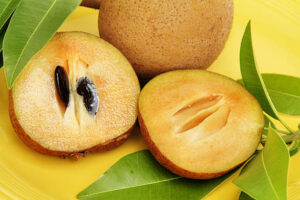Sapota and Its Impact on Diabetes Patients
Introduction
Sapota, also known as chikoo or sapodilla, is a delicious tropical fruit enjoyed for its sweet taste and smooth texture. It is rich in essential nutrients such as dietary fiber, vitamins, and minerals, making it a popular choice among fruit lovers. However, for diabetes patients, the concern lies in its natural sugar content and its impact on blood glucose levels.

nutritional profile of sapota and its effects on individuals with diabetes.
Nutritional Composition of Sapota
Sapota is packed with carbohydrates, dietary fiber, vitamins (such as Vitamin C and A), and minerals (like calcium, phosphorus, and iron). However, it is particularly rich in natural sugars, including fructose and sucrose, which contribute to its sweet taste.
A 100-gram serving of sapota contains approximately:
Calories: 83-100 kcal
Carbohydrates: 19-25g
Dietary fiber: 5-9g
Sugars: 15-20g
Proteins: 0.4-1g
Fats: 0.2-1g
While sapota offers several health benefits due to its fiber and antioxidant content, its high sugar concentration raises concerns for diabetes management.
Effects of Sapota on Diabetes Patients
Impact on Blood Sugar Levels
Sapota has a high glycemic index (GI) and glycemic load (GL), which means it can cause a rapid spike in blood glucose levels. Since diabetes patients must regulate their carbohydrate intake, consuming high-sugar fruits like sapota may lead to hyperglycemia.
Dietary Fiber and Blood Sugar Control
Despite its sugar content, sapota contains a good amount of fiber, which aids digestion and helps slow the absorption of sugars into the bloodstream. Fiber helps in stabilizing blood sugar levels, reducing sudden spikes.
Antioxidant and Anti-Inflammatory Properties
Sapota is rich in antioxidants like polyphenols and flavonoids, which help combat oxidative stress and inflammation. Chronic inflammation is a common issue in diabetes patients, and consuming antioxidant-rich foods can support overall health.
Effects on Weight Management
Obesity is a risk factor for type 2 diabetes, and high-calorie foods can contribute to weight gain. Sapota is moderately high in calories, so excessive consumption may not be ideal for individuals aiming for weight management.
Regulating Portion Sizes
Diabetes patients can still enjoy sapota in moderation by controlling portion sizes. A small portion of sapota combined with protein or healthy fats can help slow sugar absorption, making it a safer option.
How to Consume Sapota Safely with Diabetes
Portion Control: Limit sapota intake to a small serving, such as half a fruit, to minimize blood sugar spikes.
Pairing with Protein/Fiber: Consuming sapota alongside nuts, seeds, or yogurt can help slow down sugar absorption.
Avoiding Sapota Juice: Juicing removes fiber and increases the sugar concentration, leading to faster glucose absorption.
Monitoring Blood Sugar Levels: Checking blood sugar levels after consuming sapota can help assess its impact on the body.
Choosing Low-GI Fruits: Prefer low-GI fruits like berries, guava, or green apples over high-GI options like sapota for better diabetes management.
Conclusion
Sapota is a nutritious fruit that offers several health benefits but is high in natural sugars, making it a less favourable choice for diabetes patients. However, consuming it in moderation, along with proper portion control and dietary adjustments, can help minimize its impact on blood sugar levels. It is advisable for diabetes patients to consult a healthcare professional before including sapota in their diet to ensure it aligns with their individual health needs.

